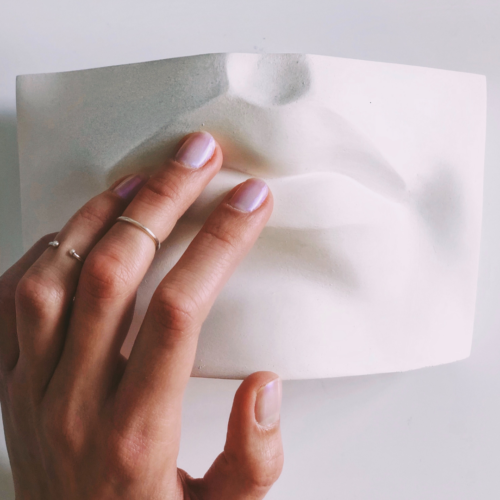Parlons sexologie
Sexualité. Société.
Santé mentale et physique

Body awareness exercice
Voici un exercice très populaire que nous donnons lors de nos suivis de couple. Cet exercice permet de garder une sensualité qui n’est pas synonyme de pression sexuelle. Suivez les indications de votre sexologue.
What is sensate focus?
Sensate focus is about touching and being touched — two distinct activities. You can maximize the potential of sensate focus by beginning without preconceived notions— of what you will experience, how it will feel, how much pleasure it will produce. In other words, begin with an open mind so as not to color your experience and feelings.
Try to avoid being judgmental or evaluative. Judgmental thinking boxes us in: Was it good? boring? ecstatic? Evaluative thinking— judgmental thinking that occurs as something is happening, not when it’s over— is even more self-defeating as it puts you in the position of being an observer rather than a participant. Observing brains are blocked from experiencing; they think too much and feel too little.
Instead of judging or evaluating, try to simply “be” and “experience.” Notice what’s happening in terms of physical feelings. By simply noticing how your partner’s skin feels (smooth, rough, warm, moist) you avoid evaluating and are able to simply focus on the experience.
Sensuality vs sexuality
Set the stage for sensuality rather than sexuality. This means that no matter how turned on you might become, please consider “off limits” the touching of genitals or breasts, having oral sex, intercourse, or other type of sexual involvement.
This “prohibition” sets a clear focus on the sensual side of touching as a distinct entity in its own right. It also serves to remove any pressure on either partner to respond in some particular way. In addition, it allows for new discoveries and avoids ingrained behavior patterns. Many couples find that time spent on the sensate focus process can be a useful and pleasant way to reawaken their own sensual (and sexual) feelings.
Try these exercises when both partners are relaxed, rested, and feeling kind toward one another. Do you best to ensure privacy and reduce distractions. Allow 30 to 40 minutes to practice. (ça peut être moins de temps que ça) Note: These exercises rely upon extensive, unimpeded skin-to-skin contact. Nudity is optimal, but if it’s not possible, avoid constricting clothing.
Step 1: non-genital touching
Ideally, both partners are undressed, showered, and free of watches or jewelry. Designate one partner as the “toucher” and the other as the “receiver” to get things started.
The receiving partner should primarily focus on their own sensations while being touched. For the moment, they are not to reciprocate touching. Instead, the receiver should simply notice the sensations—not in terms of evaluating or analyzing them, but experiencing the touch fully. The receiving partner should, however, speak up if the “toucher” does something physically or psychologically uncomfortable. We recommend this touching continue for at least 15 minutes—especially since, at the beginning, it may seem a bit awkward or unnatural, and a few minutes might be needed to get past the initial strangeness. On the other hand, we urge touching not be prolonged to the point of boredom or fatigue for either partner.
Here are some suggestions to consider with regard to the various types of touching that can be explored.
- Play a “texture awareness” game. Notice differences in the surface texture of skin on different parts of the body. How does the texture on the cheeks compare to the backs of the hands, calves, or neck? Which skin is especially silky or supple?
- Vary the firmness and tempo of touch. Feel the difference between a long-drawn-out, touch and a slightly firmer and quicker touch. Switch to a staccato type of rhythm for a while, and then back to a smoother, more languorous touch. Does changing the tempo of your touch alter sensation?
- See how touching with your whole hand feels
compared to touching just with fingertips. Notice how touching with two hands differs (or whether it differs) compared to the tactile sensations from just using one hand.
Below are three points of clarification about the process:
- If you find yourself becoming sexually-aroused, avoid turning this exploration into a sexual encounter.
- Either partner can ask to end the touching session. If you start to fall asleep, try again another time when you are both well-rested.
- The point of sensate focus in not to give your partner a massage (although that may be wonderful on another occasion) or to touch in a way that you think will make them happy. The point is to allow the person doing the touching to take in a variety of sensory experiences and to notice what they feel like, without any distractions or “shoulds.”
The second part of this exercise simply involves reversing the roles. Unless necessary, try not to take a break before switching. Avoid comparing touching styles. There’s no reason to take the same approach to touching or use the same touching sequence; you are two different people with individual feelings, instincts, and perceptions.
Some couples enjoy repeating Step 1 for a series of days. Often they notice things differently each time, and they also try out variations in technique and timing that allow them to experiment-in a non-pressured way with their sensual perceptions. The decision on whether to repeat this exercise or to move on to the next step is flexible: there’s no test to pass before you “graduate” to the next level.
Source : This text is a heavily condensed version of a chaper entitled “Sex and Sensuality;” (pp 25-41) of the book “Heterosexuality,” written by William H. Masters, PhD, Virginia E. Johnson, and Robert C. Kolodny, MD; HarperCollins, New York, 1994.
Despite the title of the book, these exercises are applicable to (and adaptable for) couples of all sexes, genders, and sexual identities.

Les 4 types de regret
Selon Daniel H. Pink, auteur du livre The Power of Regret: How Looking Back Moves Us Forward, il identifie quatre grands types de regrets universels, basés sur des recherches approfondies et des milliers de témoignages à travers le monde. 1. Regret de fondation (Foundation Regret) « Si seulement j’avais été plus…

La femme sexuelle « idéale »
La femme sexuelle idéale Dans cette activité, vous examinerez les messages que vous avez absorbés sur l’apparence et le comportement de la femme sexuelle « idéale ». Nous recevons des messages sur la femme sexuelle idéale de diverses sources, dont les idées sur l’« idéal » peuvent ou non concorder….

